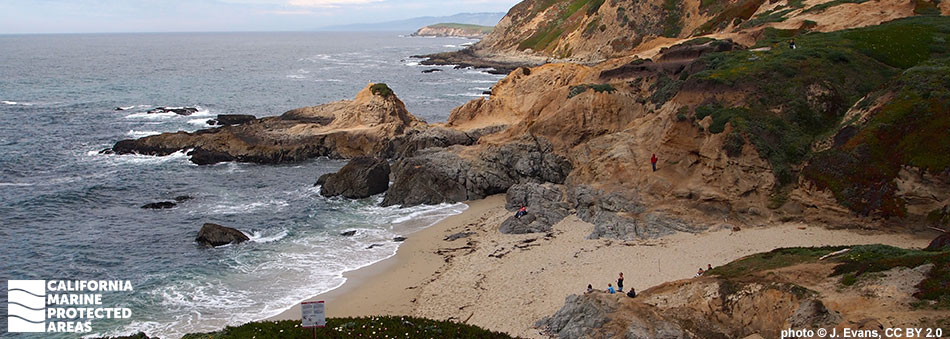
Overview
Bodega Head State Marine Reserve (SMR) sits along Sonoma County’s Bodega Head, a prominent headland 40 miles to the north of San Francisco. Bodega Head SMR lies north of and adjacent to Bodega Head State Marine Conservation Area (SMCA). Together the marine protected areas (MPAs) cover approximately 22 square miles, from shore to depths of over 260 feet. Bodega Head SMR spans about 2½ miles of shoreline and encompasses more than nine square miles of sandy beaches, rocky intertidal zones dotted with tidepools, surfgrass beds, soft sedimentary seafloor, and offshore rocky reefs.
While Bodega Head SMCA has few sandy beaches and rocky intertidal zones dotted with tidepools, it encompasses more than 12 square miles of sandy seafloor and offshore rocky reefs. One of the most expansive rocky reefs in northern California is almost entirely encompassed within these two MPAs. The rich diversity of habitats combined with offshore upwelling of nutrients provide resources for a wide range of marine life. Gray whales are frequently spotted offshore during their migration between Baja Mexico and Alaska. Seals and sea lions resting on the shore can be heard barking over the crash of the waves. Lingcod, rockfish, and greenlings live among the submerged rocks and kelp forest, and Dungeness crab scuttle across the same sandy seafloor that camouflages flatfish, such as halibut. No take of marine resources is allowed within the SMR, but the SMCA allows certain recreational and commercial take.
Regulations
Bodega Head SMR
It is unlawful to injure, damage, take, or possess any living, geological, or cultural marine resource. Additionally, within the Bodega Marine Life Refuge (a small nearshore area within Bodega Head SMR): No anchoring except as permitted by federal law, or during hazardous weather. The California Department of Fish and Wildlife and the Bodega Marine Life Refuge director may permit access, anchoring, and take for scientific or educational purposes.
California Code of Regulations Title 14, Section 632(b)(39)(opens in new tab)
Bodega Head SMCA
It is unlawful to injure, damage, take, or possess any living, geological, or cultural marine resource, EXCEPT:
Recreational take of Dungeness crab by trap, market squid by hand-held dip net, and pelagic finfish (northern anchovy, barracudas, billfishes, dorado (dolphinfish), Pacific herring, jack mackerel, Pacific mackerel, salmon, Pacific sardine, blue shark, salmon shark, shortfin mako shark, thresher shark, swordfish, tunas, Pacific bonito, and yellowtail) by trolling is allowed. Commercial take of Dungeness crab by trap, market squid by round-haul net, and pelagic finfish (no commercial take of marlin is allowed) by trolling or round-haul net is allowed. Not more than five percent by weight of any commercial pelagic finfish or market squid catch landed or possessed shall be other incidentally taken species.
California Code of Regulations Title 14, Section 632(b)(40)(opens in new tab)
Quick Facts
Bodega Head SMR
MPA size: 9.34 square miles
Shoreline span: 2.4 miles
Depth range: 0 to 266 feet
Habitat composition*:
- Rock: 5.15 square miles
- Sand/mud: 6.48 square miles
Bodega Head SMCA
MPA size: 12.31 square miles
Shoreline span: 0.2 miles
Depth range: 0 to 267 feet
Habitat composition*:
- Rock: 5.80 square miles
- Sand/mud: 7.98 square miles
*Habitat calculations are based on three-dimensional area and may exceed the total MPA area listed above.